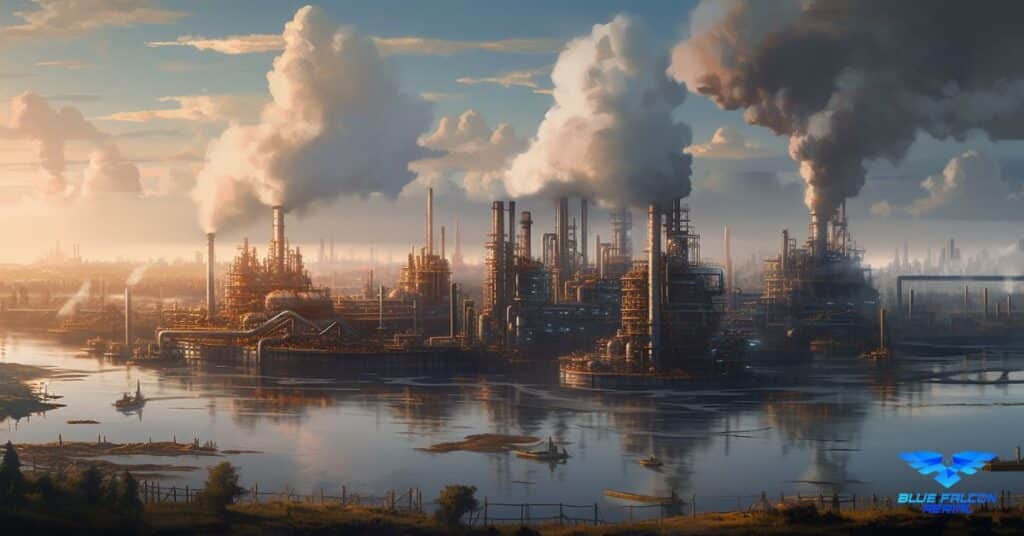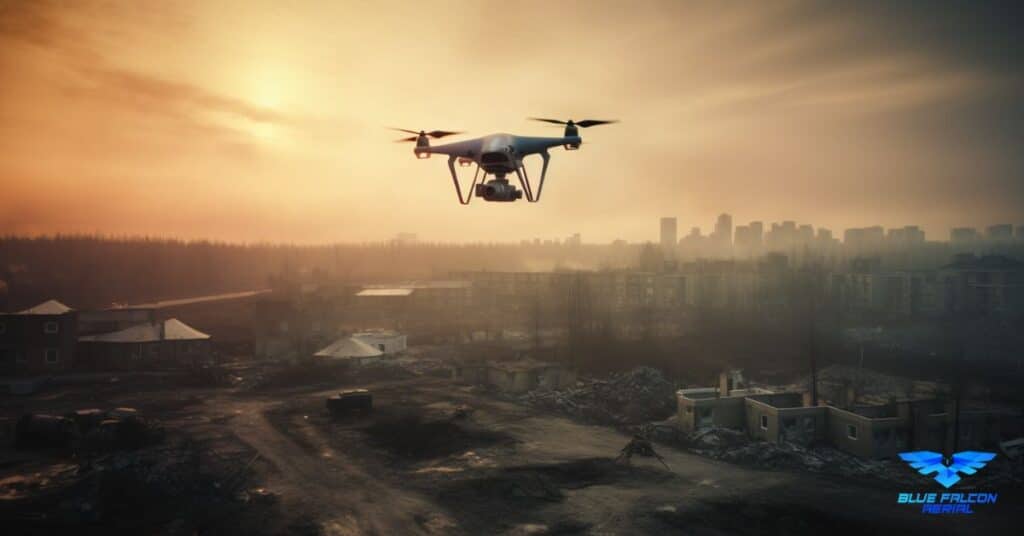The oil and gas industry has always been at the forefront of adopting innovative technologies to improve efficiency and reduce costs. One such technology that has gained significant traction in recent years is LiDAR (Light Detection and Ranging). This powerful remote sensing tool has revolutionized the way oil and gas companies approach their operations, from exploration to refining. In this article, we will delve into the world of LiDAR in oil and gas, examining its various applications and the benefits it brings to the industry.
What is LiDAR Technology and How Does It Work in the Oil and Gas Industry?
LiDAR, an acronym for Light Detection and Ranging, is a remote sensing technology that uses laser pulses to measure distances and generate detailed 3D images of the Earth’s surface. LiDAR works by emitting laser beams from a device mounted on a drone, aircraft, or ground-based vehicle. The beams then bounce off objects on the ground, and the time it takes for the light to return is recorded. By calculating the travel time of the laser pulses, the system can determine the distance between the LiDAR sensor and the objects, resulting in highly accurate elevation data.
In the oil and gas industry, LiDAR has become a valuable tool for various applications, from exploration to monitoring and maintenance. The high-resolution 3D data generated by LiDAR systems can provide critical insights into the terrain, subsurface structures, and other environmental features, enabling companies to make better decisions and optimize their operations.
Applications of LiDAR in the Oil and Gas Industry
Exploration and Site Selection
The use of LiDAR technology has significantly improved the process of identifying potential drilling sites and assessing geological structures. By providing detailed topographic data and high-resolution images, LiDAR enables oil and gas companies to accurately map subsurface formations, detect fault lines, and identify suitable drilling locations with minimal environmental impact. This information helps operators make informed decisions about where to drill and reduces the risks associated with exploration activities.
Pipeline Monitoring and Maintenance
LiDAR is an essential tool for monitoring pipeline networks, enabling operators to detect potential issues before they become critical. By capturing high-resolution data on pipeline routes and surrounding terrain, LiDAR systems can help identify areas prone to erosion, landslides, or other hazards that could impact pipeline integrity. Furthermore, LiDAR can be used to monitor vegetation encroachment and detect unauthorized construction activities near pipelines, ensuring timely intervention and minimizing the risk of damage.
Refining and Storage Facilities
LiDAR technology can also be applied to refining and storage facilities, providing valuable data for facility planning, design, and maintenance. By generating accurate 3D models of these facilities, LiDAR allows engineers to assess their structural integrity, identify potential safety hazards, and optimize facility layouts for maximum efficiency. Additionally, LiDAR can be used to monitor the condition of storage tanks, detecting deformations, and potential leaks before they become critical.
Environmental Impact Assessments
One of the key responsibilities of oil and gas companies is to minimize the environmental impact of their operations. LiDAR technology can play a crucial role in this aspect by facilitating environmental impact assessments and monitoring changes in land use and vegetation over time. With accurate and up-to-date data, companies can better understand the effects of their activities on the environment and implement mitigation strategies to reduce their ecological footprint.
Specific Questions about LiDAR in the Oil and Gas Industry
How Can LiDAR Technology Help Optimize Pipeline Construction?
Pipeline construction is a complex process that requires careful planning and execution to ensure safety, efficiency, and minimal environmental impact. LiDAR technology can greatly contribute to pipeline construction optimization by providing high-resolution, accurate topographical data that helps engineers to:
- Identify optimal pipeline routes: By analyzing the terrain, slope, and other geographical features, LiDAR data allows engineers to determine the most efficient and cost-effective pipeline routes with minimal environmental impact.
- Detect potential obstacles: LiDAR can detect natural and man-made obstacles such as rivers, roads, and buildings, enabling engineers to avoid or plan for these challenges during pipeline construction.
- Assess geohazards: LiDAR can identify geological hazards, such as fault lines and landslides, that could impact pipeline integrity, allowing for proactive measures to mitigate these risks.
- Optimize pipeline design: By providing accurate elevation data, LiDAR helps engineers design pipeline systems that account for terrain variations and maintain proper clearances from the ground, reducing the risk of damage due to erosion or other environmental factors.
Can LiDAR Detect Methane Leaks in Oil and Gas Facilities?
Yes, LiDAR can be used to detect methane leaks in oil and gas facilities. Specialized LiDAR systems, such as Differential Absorption LiDAR (DIAL), can identify and quantify methane emissions by measuring the absorption of laser light by methane molecules in the atmosphere. By scanning facilities with DIAL systems, operators can pinpoint the location of leaks and take corrective action, minimizing the environmental impact and potential safety hazards associated with methane emissions.
What Is the Difference Between LiDAR and Radar Technology in the Oil and Gas Industry?
Both LiDAR and radar are remote sensing technologies that use electromagnetic waves to measure distances and create detailed images of the Earth’s surface. However, there are key differences between the two technologies:
- Wavelength: LiDAR uses laser light in the visible or near-infrared spectrum, while radar uses radio waves. As a result, LiDAR typically provides higher resolution data than radar.
- Penetration: Radar waves can penetrate through certain materials, such as soil and vegetation, making it suitable for subsurface mapping. LiDAR, on the other hand, is more effective for surface mapping and topographic data collection.
- Sensitivity to environmental conditions: LiDAR can be affected by atmospheric conditions, such as clouds and fog, which can scatter or absorb the laser light. Radar is less sensitive to atmospheric conditions and can operate effectively in various weather conditions.
In the oil and gas industry, both LiDAR and radar have their applications, with LiDAR being particularly useful for surface mapping, pipeline monitoring, and facility planning, while radar is more commonly used for subsurface exploration and mapping.
How Can LiDAR Technology Improve Drilling Site Selection and Geological Mapping in the Oil and Gas Industry?
LiDAR technology can greatly enhance drilling site selection and geological mapping in the oil and gas industry by providing high-resolution, accurate topographical data and 3D images of the Earth’s surface. This information enables companies to:
- Identify promising geological formations: LiDAR data can reveal subsurface structures and fault lines, helping geologists to identify formations that are likely to contain hydrocarbon deposits.
- Assess terrain suitability: By analyzing the terrain, slope, and other geographical features, LiDAR helps operators determine the most suitable locations for drilling operations, minimizing environmental impact and reducing the risk of drilling-related issues.
- Optimize well placement: With accurate topographical data, operators can optimize well placement to maximize hydrocarbon extraction and minimize the number of required wells, reducing both costs and environmental impact.
What Are the Benefits of Using LiDAR Technology in Oil and Gas Exploration?
The use of LiDAR technology in oil and gas exploration offers several significant benefits, including:
- Improved accuracy: LiDAR provides high-resolution, precise data on the Earth’s surface and subsurface structures, enabling companies to make better-informed decisions about exploration and drilling activities.
- Faster data acquisition: LiDAR systems mounted on drones or aircraft can cover vast areas quickly, allowing for rapid data collection and analysis compared to traditional surveying methods.
- Reduced environmental impact: By helping to identify optimal drilling locations and minimize surface disturbances, LiDAR technology contributes to more sustainable and environmentally friendly exploration practices.
- Cost savings: With improved accuracy and faster data acquisition, LiDAR can help reduce the costs associated with exploration, such as the need for multiple drilling attempts or extensive ground-based surveys.
How Does Mobile LiDAR Scanning Work in Oil and Gas Facilities?
Mobile LiDAR scanning involves mounting a LiDAR system on a vehicle, such as a truck or an unmanned ground vehicle (UGV), to collect data while the vehicle is in motion. This approach allows for rapid and efficient data acquisition in oil and gas facilities, providing valuable information for facility planning, maintenance, and safety assessments.
In the context of oil and gas facilities, mobile LiDAR scanning can be used to:
- Create 3D models of facility infrastructure: Mobile LiDAR systems can generate detailed 3D models of pipelines, storage tanks, processing plants, and other infrastructure, helping engineers and operators to optimize facility design and maintenance.
- Monitor facility conditions: Regular mobile LiDAR scans can track changes in facility infrastructure and detect potential issues, such as deformation, corrosion, or leaks, before they become critical.
- Assess safety hazards: By identifying potential hazards, such as obstructions, uneven terrain, or insufficient clearances, mobile LiDAR scanning can help facility operators maintain a safe working environment.
What Are the Different Types of LiDAR Technology Used in the Oil and Gas Industry?
There are several types of LiDAR technology that can be employed in the oil and gas industry, including:
- Airborne LiDAR: Mounted on drones or aircraft, airborne LiDAR systems can cover large areas quickly and are commonly used for exploration, pipeline monitoring, and environmental impact assessments.
- Terrestrial LiDAR: Ground-based LiDAR systems, either stationary or mobile, are often used for facility mapping, infrastructure inspection, and safety assessments.
- Differential Absorption LiDAR (DIAL): This specialized type of LiDAR is designed to detect and quantify specific gases, such as methane, by measuring the absorption of laser light by gas molecules. DIAL systems can be used for leak detection and emissions monitoring in oil and gas facilities.
How Far Can LiDAR Detect in Oil and Gas Facilities?
The detection range of LiDAR systems depends on several factors, such as the type of LiDAR system, the power of the laser, the sensitivity of the sensor, and the atmospheric conditions. In general, airborne LiDAR systems can have a detection range of up to several kilometers, while terrestrial LiDAR systems typically have a shorter range, often up to a few hundred meters.
In the context of oil and gas facilities, the detection range of LiDAR systems is usually sufficient to provide accurate and detailed data for facility planning, monitoring, and maintenance.
Can LiDAR Technology Be Used to Identify New Drilling Locations in the Oil and Gas Industry?
Yes, LiDAR technology can be used to identify new drilling locations in the oil and gas industry. By providing high-resolution, accurate data on the Earth’s surface and subsurface structures, LiDAR can help geologists and engineers identify promising geological formations that may contain hydrocarbon deposits. The detailed topographical data provided by LiDAR also enables operators to assess the suitability of potential drilling locations, taking into account factors such as terrain, slope, and environmental impact.
Moreover, LiDAR technology can be combined with other geophysical and geological data, such as seismic surveys and well logs, to create a comprehensive understanding of subsurface structures and improve the accuracy of drilling location predictions. This integrated approach enables oil and gas companies to optimize their exploration activities, reduce drilling risks, and increase the efficiency of their operations.
In summary, LiDAR technology has become an indispensable tool in the oil and gas industry, providing valuable insights and data for various applications, from exploration and drilling site selection to pipeline monitoring and facility maintenance. By enabling companies to make better-informed decisions and optimize their operations, LiDAR technology is helping to minimize the environmental impact of oil and gas activities and improve overall industry efficiency.
Benefits of Using LiDAR in Oil and Gas Operations
The adoption of LiDAR technology in the oil and gas industry has brought several benefits, contributing to more efficient, safer, and environmentally friendly operations.
Cost Savings
LiDAR technology can lead to significant cost savings by reducing the need for extensive ground-based surveys, optimizing well placement, and minimizing the number of required drilling attempts. Faster data acquisition and the ability to identify potential obstacles and geohazards early on also contribute to cost reductions.
Increased Efficiency and Accuracy
High-resolution, precise data provided by LiDAR systems enables companies to make better-informed decisions about exploration, drilling, and facility planning. This improved accuracy results in more efficient operations and a higher likelihood of successful drilling outcomes.
Enhanced Safety
By identifying potential hazards and monitoring facility conditions, LiDAR technology helps maintain a safe working environment for personnel. Early detection of issues, such as leaks or infrastructure deformation, allows for timely corrective action, reducing the risk of accidents or environmental incidents.
Reduced Environmental Footprint
LiDAR technology contributes to more sustainable and environmentally friendly oil and gas operations by helping to identify optimal drilling locations, minimizing surface disturbances, and enabling the early detection of leaks or emissions.
Benefits of Using LiDAR in Oil and Gas Operations
The adoption of LiDAR technology in the oil and gas industry has brought several benefits, contributing to more efficient, safer, and environmentally friendly operations.
Cost Savings
LiDAR technology can lead to significant cost savings by reducing the need for extensive ground-based surveys, optimizing well placement, and minimizing the number of required drilling attempts. Faster data acquisition and the ability to identify potential obstacles and geohazards early on also contribute to cost reductions.
Increased Efficiency and Accuracy
High-resolution, precise data provided by LiDAR systems enables companies to make better-informed decisions about exploration, drilling, and facility planning. This improved accuracy results in more efficient operations and a higher likelihood of successful drilling outcomes.
Enhanced Safety
By identifying potential hazards and monitoring facility conditions, LiDAR technology helps maintain a safe working environment for personnel. Early detection of issues, such as leaks or infrastructure deformation, allows for timely corrective action, reducing the risk of accidents or environmental incidents.
Reduced Environmental Footprint
LiDAR technology contributes to more sustainable and environmentally friendly oil and gas operations by helping to identify optimal drilling locations, minimizing surface disturbances, and enabling the early detection of leaks or emissions.
Case Studies: Successful Use of LiDAR in the Oil and Gas Sector
Several companies in the oil and gas industry have successfully implemented LiDAR technology, showcasing its value and potential for a wide range of applications:
- Pipeline Monitoring: A major pipeline operator used LiDAR to create a 3D model of their pipeline network, allowing them to monitor the condition of their assets and identify potential issues, such as erosion, vegetation encroachment, and third-party intrusions.
- Leak Detection: An oil and gas company deployed Differential Absorption LiDAR (DIAL) systems to detect and quantify methane emissions at their facilities, enabling them to pinpoint the location of leaks and take corrective action.
- Drilling Site Selection: A multinational energy company used LiDAR data, combined with other geophysical and geological information, to identify promising geological formations for drilling, resulting in the discovery of a significant hydrocarbon deposit.
The Future of LiDAR in Oil and Gas Operations
As technology continues to advance, the applications and potential benefits of LiDAR in the oil and gas industry are expected to grow. Some key developments and trends for the future of LiDAR in oil and gas operations include:
- Advancements in LiDAR Technology: Continued improvements in LiDAR technology, such as increased detection range, higher resolution, and more efficient data processing, will enable even more precise and accurate data collection and analysis.
- Integration with Emerging Technologies: The integration of LiDAR with other cutting-edge technologies, such as artificial intelligence, machine learning, and advanced data analytics, will further enhance its capabilities and applications in the oil and gas sector.
- Expanded Applications: As the industry becomes more familiar with LiDAR and its potential benefits, new applications are likely to emerge, including subsurface mapping, real-time monitoring of drilling operations, and advanced automation of facility management processes.
In conclusion, LiDAR technology is poised to play an increasingly important role in the oil and gas industry, helping companies to optimize their operations, enhance safety, and reduce their environmental footprint.
Partner with Blue Falcon Aerial for Drone-Based Oil and Gas Projects
If your company is looking to harness the power of LiDAR and drone technology for oil and gas operations, consider partnering with Blue Falcon Aerial, a trusted provider of comprehensive drone-based solutions tailored to the needs of the industry.
Blue Falcon Aerial specializes in providing innovative and cost-effective services for oil and gas companies, including aerial LiDAR mapping, pipeline inspections, and environmental assessments. With extensive experience and a proven track record in the sector, Blue Falcon Aerial can help you unlock the full potential of LiDAR technology and improve the efficiency, safety, and sustainability of your operations.
To learn more about how Blue Falcon Aerial can assist your organization, visit their Oil and Gas Services page, which outlines their comprehensive suite of solutions tailored to the specific needs of the industry. Blue Falcon Aerial also offers a wide range of Deliverables that can be customized to meet your project requirements, ensuring you receive the highest-quality data and insights to drive your business forward.
Don’t miss the opportunity to leverage the expertise of Blue Falcon Aerial for your drone-based oil and gas projects. Contact them today to discuss your needs and discover how they can help you achieve your goals in the dynamic and evolving world of oil and gas operations.




